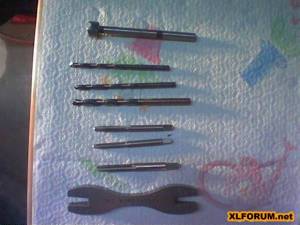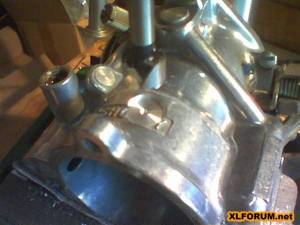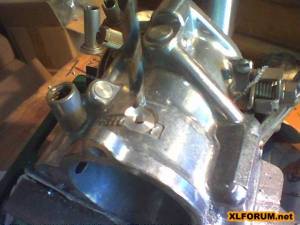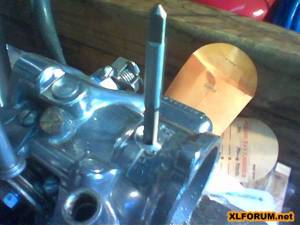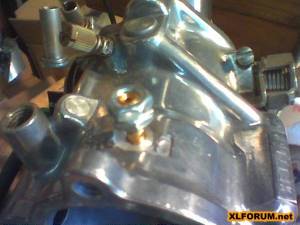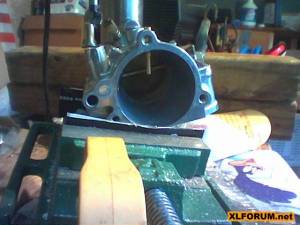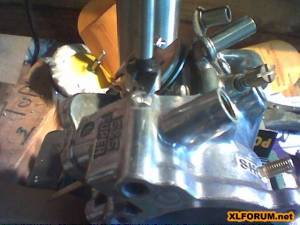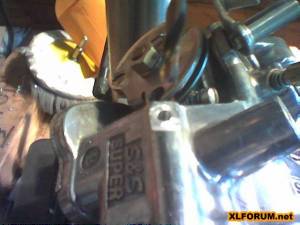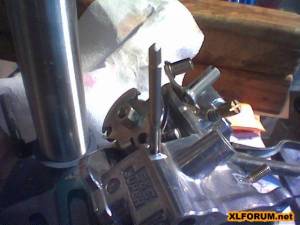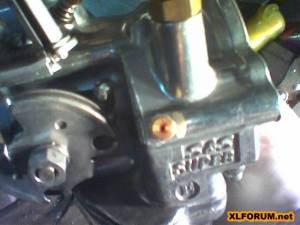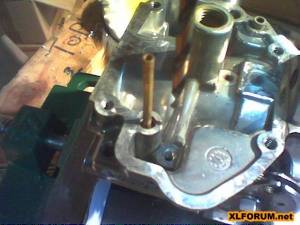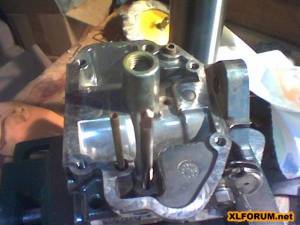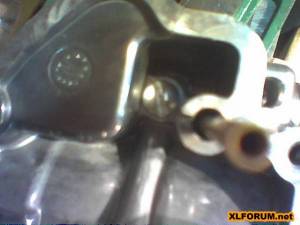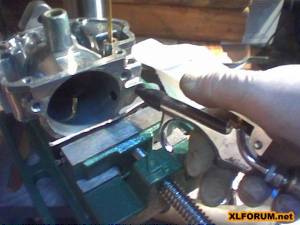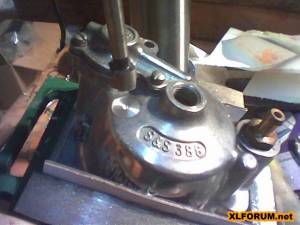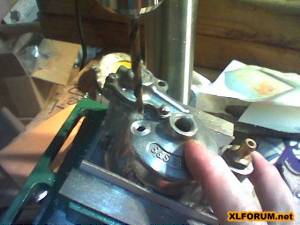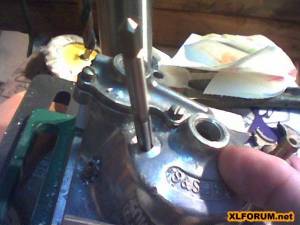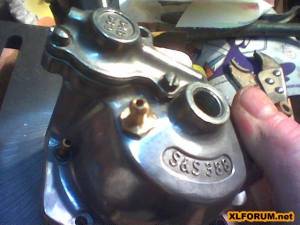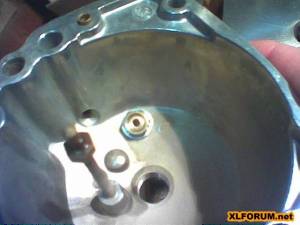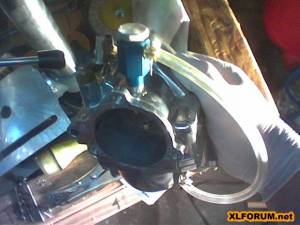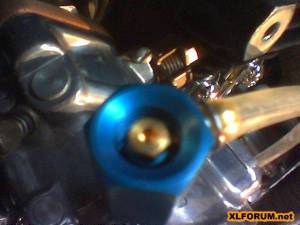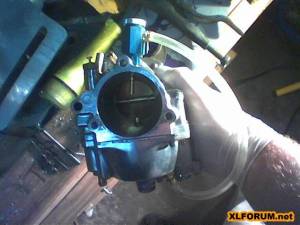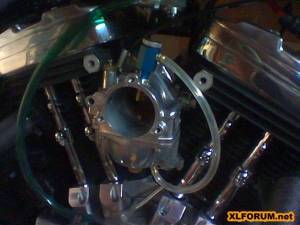REF: Carburetor, Intake Manifold & Exhaust - Sub-01Q
Installing a ThunderJet® on a Super E
Article by biknut of the XLFORUM 1)
Note: This product is not for sale or use on pollution controlled vehicles.
S&S Super E's are good carbs.
But old ones have a problem trying to carburete properly over the entire RPM range when you start making big horsepower because they only have 2 jets.
If you jet the mid range right, it goes lean on the top end. If you jet the top end right it's too rich in the mid range.
There's a need for a third fuel circuit. Fortunately there's a fix called a ThunderJet.
First you have to understand why you need a tj in the first place. A Super E is a good crab, but because it only has 2 jets, it's range is pretty limited jetting wise. Even so it does a pretty good job on a fairly stock motor. The problem occurs when you add ported heads, big cams, high compression, and open exhaust.
On this kind of motor what you run up against on the street is that your Super E cannot be adjusted for proper fueling through the entire rpm range. Typically you have to make a choice. You can jet for good top end, but you'll run very rich in the mid range. If you try to lean out the mid range, you'll end up way too lean on the top end. Not really a problem for the drag strip, but sucks on the street.
This is where a Thunderjet comes into play.
A properly installed tj allows the main jet to mostly control only the mid range, and the tj takes over the demand of the top end.
Now you can lean out the mid range for proper AFR, and let the tj handle the top end.
In addition, the main jet air bleed circuit is altered. Now you can fine tune the main jet, by changing the air bleed jet.
This allows you to fine tune the main jet 10x smaller than changing the main jet one size, remembering the main jet mostly just controls the mid range.
Because of all this adjustability you can also now change the pilot jet for more accurate fueling of the bottom end, because there's less demand on it from the mid range.
So while it's true you probably won't get more peak HP, you will have more HP over a broader rpm range after tuning.
Installing a Thunderjet can be difficult and it may be better to simply buy a carb that already has a ThunderJet installed.
Zipper's is the distributor https://www.zippersperformance.com/thunderjet-ss-eb-carbs.html.
But you can buy this through from a local indy through Drag Specialty's delivered in one day for about $50.
Tools needed:
- Drill press
- Machinist vise
- Three different size drill bits and taps.
- 1/2“ end mill (1/2” Forstner bit for wood working was used here)
The Forstner bit is technically for wood working, but for soft aluminum it'll work fine.
The first thing to do is remove the carb from the bike and take it apart.
The first step in the instructions is to drill the hole for the fuel delivery tube of the ThunderJet.
Instead of drilling the hole first, I decided to instead mill the 1/2“ spot surface first then drill the hole.
The reason for this is because Forstner bits have a tiny point in the center that makes it easier to drill the center of the spot surface.
The instructions tell you to center the hole .950” from the air cleaner mounting surface. That turned out to be not quite far enough.
Mine ended up about .988“ and it still was a little too close the air cleaner back plate and slightly contacted a screw that holds on the choke lever on.
My answer was to remove the lever. I never use the choke anyway, and if I need to they sell better devises to operate it.
You have to double nut the fuel delivery tube to install it.
Now moving on to the new air bleed hole.
Next we need to plug the original air bleed hole. Don't drill too deep.
A screw is provided in the kit for plugging the hole. Don't forget to blow out the passages.
I decided to skip option 6. I don't think it's necessary for a 1200 motor if you're not revving to 7500 RPM.
Now moving on to the float bowl. We have to install the fuel nipple that supplies fuel to the ThunderJet.
Here's the ThunderJet installed on the carb. Also a picture looking at the jet inside the ThunderJet body.
Then the fuel line is installed and you have the finished product.
After the tuning process was final my bike now responds like fuel injection.
I was able to turn down the accelerator pump in comparision to before the ThunderJet.
It's at about 2 turns now compared to about 4 turns before. Jetting ended up .295/64/150 and 140 air bleed jet.
After a lot more tuning and a different exhaust system, jetting ended up 29.5/64/175ab 160tj.
The ThunderJet doesn't do anything at all till about 4000 RPM. Then from 4000 to 4500 it gradually increases. At 4500 it goes nuclear.
When you're riding you can look down at the feed line and see when it starts flowing gas, if you don't mind taking your eyes off the road at 90 mph.
You could change the main jet if your that high in the RPM range if you're drag racing and only interested in top end power.
But for street riding a problem occurs mainly when running open pipes with lots of reversion.
The reversion causes a rich condition around 3200 rpm.
Super E's have a limited ability to tune out the richness because they only have 2 jets that have to control the entire rev range.
If you lean out the main jet enough to correct the rich mid range condition the top end goes way lean.
If you jet the main jet correct for the top end the mid range is way too rich.
The purpose of the ThunderJet is to add a third fuel circuit to handle the top end, allowing the main jet to be dedicated more to correcting the mid range.
The addition of the adjustable air bleed jet allows very fine tuning of the main jet circuit, totally independent of the other jets.
Instead of changing main jets from one size to the next, you get at least 8 smaller steps in between.
Here's my first dyno chart tuned from butt tuning. This is a Super E without a ThunderJet.
The jetting is 28/68. Any pilot jet smaller than a 28 caused hard starting and hesitation on roll ons at about 50 mph.
Any bigger pilot jet made the mid range even richer. As you can see the mid range is way too rich.
Dropping the main jet to a 66 made the top end go too lean.
After further dyno testing I found that even with a 62 main jet the mid range was still a little too rich.
But by then the top end was dangerously too lean.

